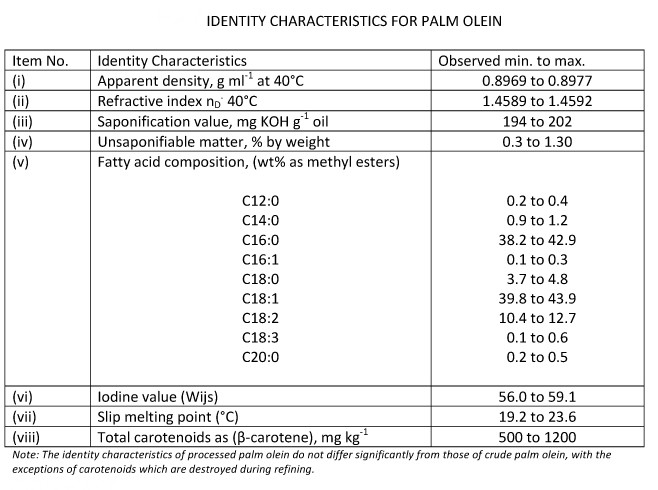What is palm olein?
FAQ / Chat on line / Give me a price / Date: October 7, 2016
General Description:
Palm olein is the liquid fraction obtained from fractionation of palm oil. The fractionation process involves a physical process of cooling the oil under controlled conditions to low temperatures, followed by filtration of the crystals through membrane press. The liquid olein and solid stearin are products of fractionation, and they are the major products exported.
Palm olein is fully liquid at ambient temperature in warm climates. It can be blended with various vegetable oils in different proportions to obtain liquid oils which can withstand lower temperatures. For example, blends of palm olein with more than 70% soft oils such as soyabean oil, corn oil or canola oil remain clear at 0°C for at least 5 hr. Oxidative stability of soft oils are also extended and improved by the palm olein. Basically, there are two major grades of palm olein: standard olein and super olein (iodine value greater than 60). The standard olein has an iodine value of about 56-59 and cloud point of 10°C max. The specifications are given in Malaysian Standard MS816:2007(Table 3). Super olein is more suited to cooler climates and has cloud points of about 2°C-5°C.

Palm olein characteristics
Palm olein is the liquid fraction obtained from fractionation of palm oil. The fractionation process involves a physical process of cooling the oil under controlled conditions to low temperatures, followed by filtration of the crystals through membrane press. The liquid olein and solid stearin are products of fractionation, and they are the major products exported.
Palm olein is fully liquid at ambient temperature in warm climates. It can be blended with various vegetable oils in different proportions to obtain liquid oils which can withstand lower temperatures. For example, blends of palm olein with more than 70% soft oils such as soyabean oil, corn oil or canola oil remain clear at 0°C for at least 5 hr. Oxidative stability of soft oils are also extended and improved by the palm olein. Basically, there are two major grades of palm olein: standard olein and super olein (iodine value greater than 60). The standard olein has an iodine value of about 56-59 and cloud point of 10°C max. The specifications are given in Malaysian Standard MS816:2007(Table 3). Super olein is more suited to cooler climates and has cloud points of about 2°C-5°C.

Palm olein characteristics
Properties of Palm Olein (standard grade)
Both normal palm olein and super olein are suitable as cooking oils, especially for deep fat or shallow frying. The high stability of the oil makes it exceptionally suitable for frying purposes. A high content of tocotrienols is generally present in oleins, being partitioned preferentially into this phase during fractionation. Sold fat content shows that the oil is liquid at 20°C-25°C.
Properties of Super Olein
Super olein has a higher iodine value of 60 or above. These oleins have better clarity and lower tendency to turn cloudy compared to normal olein. Solid fat content data shows that the olein is generally clear at 17°C. It is interesting that super oleins with iodine value above 62 have much lower solid fat content. These oleins are also suitable as cooking and frying oils. Blending normal or super olein with unsaturated oils results in mixtures with different compositions and clarity to cater for different market requirements.
Both normal palm olein and super olein are suitable as cooking oils, especially for deep fat or shallow frying. The high stability of the oil makes it exceptionally suitable for frying purposes. A high content of tocotrienols is generally present in oleins, being partitioned preferentially into this phase during fractionation. Sold fat content shows that the oil is liquid at 20°C-25°C.
Properties of Super Olein
Super olein has a higher iodine value of 60 or above. These oleins have better clarity and lower tendency to turn cloudy compared to normal olein. Solid fat content data shows that the olein is generally clear at 17°C. It is interesting that super oleins with iodine value above 62 have much lower solid fat content. These oleins are also suitable as cooking and frying oils. Blending normal or super olein with unsaturated oils results in mixtures with different compositions and clarity to cater for different market requirements.



